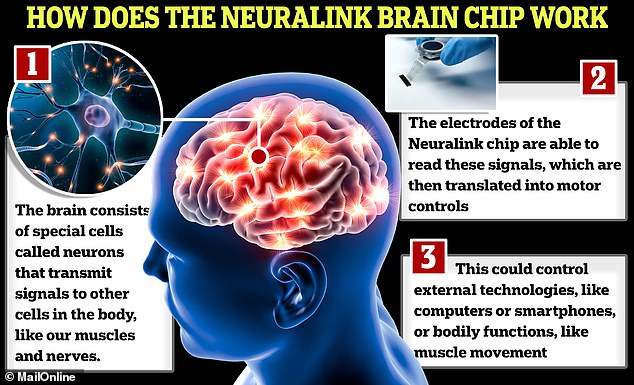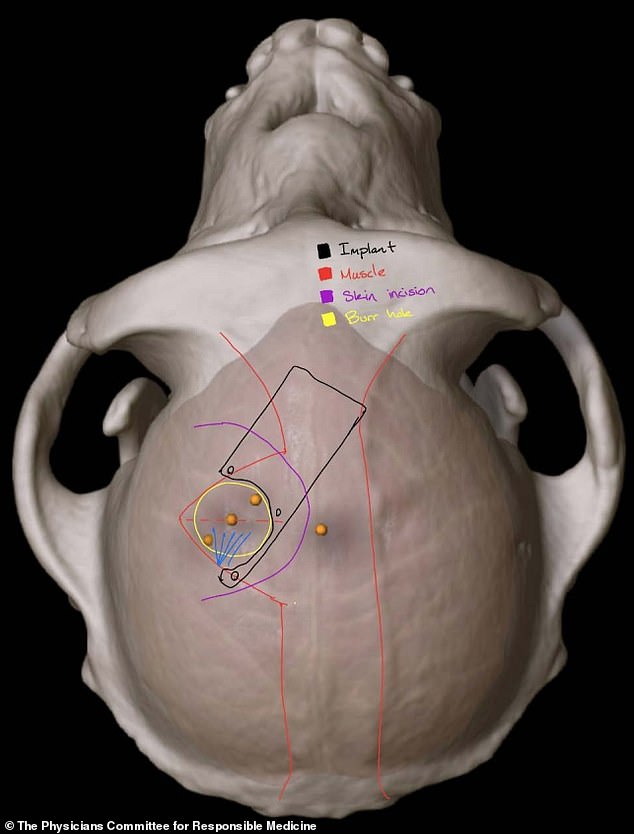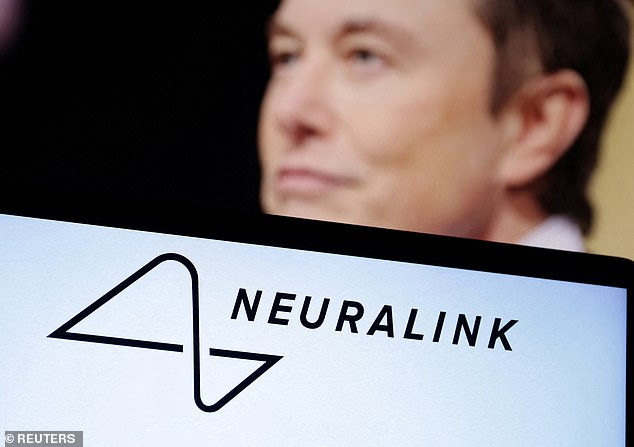Would you sign up? ‘Thousands of people’ want part of their skull removed and one of Elon Musk’s Neuralink brain chips implanted, claims report
The idea of having part of your skull removed and a brain chip implanted may sound like a nightmare.
But according to a new report, “thousands of people” have expressed interest in doing just that.
Elon Musk’s company, Neuralink, has a vision of treating conditions such as paralysis and blindness by linking brains to computers using microchips.
But to achieve this, a number of volunteers are needed who are ‘willing to have a piece of their skull removed’ so that a robot can place a chip in their brain and prove that the technology works in humans.
The implants have so far only been tested on monkeys and pigs.
Keen: Thousands of people are said to have expressed interest in having one of Elon Musk’s controversial brain chips implanted in their skulls as part of an experimental study on humans

How it works: The chips are designed to interpret signals produced in the brain and relay information to devices via Bluetooth, with the aim of allowing a participant to control a computer cursor or keyboard using only their thoughts
One of Musk’s biographers, Ashlee Vance, suggested that Neuralink had received “an outpouring of interest from thousands of potential patients” who wanted to act as human guinea pigs.
He said the company had yet to implant its device in a human, but wanted to operate on 11 people next year and more than 22,000 by 2030.
It is unclear whether participants will be paid to participate.
Neuralink launched a recruitment drive for its first human trials in September, saying it was looking for people with paralysis to test its experimental device as part of a six-year study.
But the company has been dogged by controversy in recent years, raising ethical concerns and skepticism among neuroscientists and other experts.
Vance, author of the 2015 biography “Elon Musk: Tesla, SpaceX, and the Quest for a Fantastic Future,” wrote in a Bloomberg report that the ideal candidate for Neuralink’s first human trial was “an adult under the age of 40 whose four limbs are paralyzed.”
He explained that it would take a “couple of hours” for a surgeon to perform a craniectomy and another 25 minutes for the chip to be inserted by a robot into the area of the brain that controls the hands, wrists and forearms.
“The goal is to demonstrate that the device can safely collect useful data from that part of the patient’s brain, an important step in Neuralink’s efforts to convert a person’s thoughts into a series of commands that a computer can understand,” Vance added.
He said the implant would relay this information to a nearby laptop or tablet.
Vance, who said he had visited Neuralink’s facilities 10 times in three years, also revealed how Musk pushed his company to fend off the threat from similar brain-computer startups Synchron and Onward.
Both have already begun human trials, leading the billionaire to conclude last year that the two companies were “kicking our ass right now.”
In response, he allegedly told Neuralink to pick up the pace “as if the world was ending,” Vance said.

Where it will go: The study will use a robot to surgically place a brain-computer interface (BCI) implant in a part of the brain that controls movement, Neuralink added. Pictured is a scan showing the implant in an animal’s brain
Safety concerns caused the company to struggle for a while to get the necessary approval for human trials, especially from the U.S. Food and Drug Administration (FDA).
Major issues involved the device’s lithium battery, the possibility of the implant’s wires migrating within the brain, and the challenge of safely removing the device without damaging brain tissue.
The FDA later granted its approval in May, but did not disclose how its initial concerns were resolved.
Despite the controversy, Musk, CEO of SpaceX and Tesla, has big ambitions for Neuralink. He says the company will facilitate rapid surgical insertions of its chip devices to treat conditions such as obesity, autism, depression and schizophrenia.
It would also enable web browsing and telepathy.
But even if the device proves safe for human use, it could still potentially take more than a decade before Neuralink is cleared to market it, experts warn.

Goal: Neuralink wants to treat conditions such as paralysis and blindness by linking brains to computers using microchips
They say the brain implants will need to be extensively tested to overcome technical and ethical challenges if they are to become widely available.
Musk’s company – which was only founded in 2016 – has repeatedly overestimated the speed at which it is delivering on its promises.
Initially, Neuralink wanted to start inserting chips into people in 2020, and then push this back to 2022.
Now it seems more likely that this won’t happen until 2024.
There was also a word of caution from one of the company’s executives in response to Musk’s demands.
Referring to the fate of SpaceX’s first few rocket launches, Shivon Zilis, Neuralink special projects director and mother of two of Musk’s children, told Vance: “We can’t blow up the first three. That’s not an option here.’

